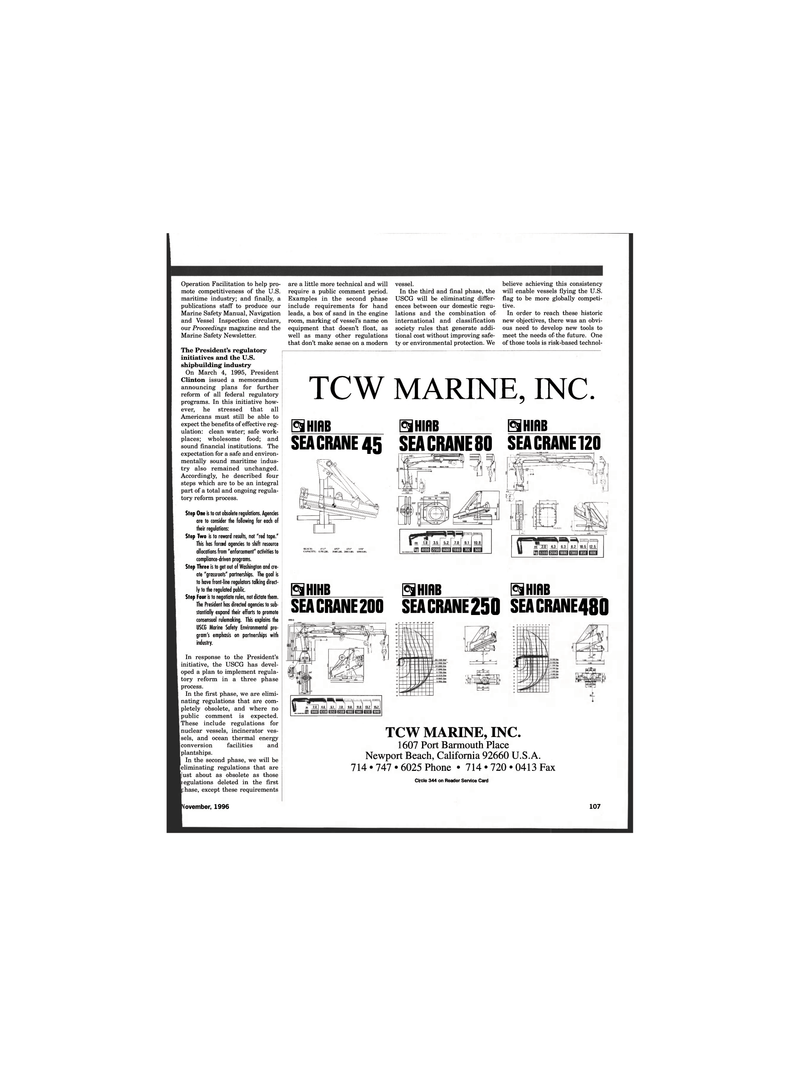
Page 105: of Maritime Reporter Magazine (November 1996)
Read this page in Pdf, Flash or Html5 edition of November 1996 Maritime Reporter Magazine
Operation Facilitation to help pro- mote competitiveness of the U.S. maritime industry; and finally, a publications staff to produce our
Marine Safety Manual, Navigation and Vessel Inspection circulars, our Proceedings magazine and the
Marine Safety Newsletter.
The President's regulatory initiatives and the U.S. shipbuilding industry
On March 4, 1995, President
Clinton issued a memorandum announcing plans for further reform of all federal regulatory programs. In this initiative how- ever, he stressed that all
Americans must still be able to expect the benefits of effective reg- ulation: clean water; safe work- places; wholesome food; and sound financial institutions. The expectation for a safe and environ- mentally sound maritime indus- try also remained unchanged.
Accordingly, he described four steps which are to be an integral part of a total and ongoing regula- tory reform process.
Step One is to cut obsolete regulations. Agencies are to consider the following for each of their regulations:
Step Two is to reward results, not "red tape."
This has forced agencies to shift resource allocations from "enforcement" activities to compliance-driven programs.
Step Three is to get out of Washington and cre- ate "grassroots" partnerships. The goal is to have front-line regulators talking direct- ly to the regulated public.
Step Four is to negotiate rules, not dictate them.
The President has directed agencies to sub- stantially expand their efforts to promote consensual rulemaking. This explains the
USCG Marine Safety Environmental pro- gram's emphasis on partnerships with industry.
In response to the President's initiative, the USCG has devel- oped a plan to implement regula- tory reform in a three phase process.
In the first phase, we are elimi- nating regulations that are com- pletely obsolete, and where no public comment is expected.
These include regulations for nuclear vessels, incinerator ves- sels, and ocean thermal energy conversion facilities and plantships.
In the second phase, we will be eliminating regulations that are 'ust about as obsolete as those egulations deleted in the first hase, except these requirements are a little more technical and will require a public comment period.
Examples in the second phase include requirements for hand leads, a box of sand in the engine room, marking of vessel's name on equipment that doesn't float, as well as many other regulations that don't make sense on a modern vessel.
In the third and final phase, the
USCG will be eliminating differ- ences between our domestic regu- lations and the combination of international and classification society rules that generate addi- tional cost without improving safe- ty or environmental protection. We believe achieving this consistency will enable vessels flying the U.S. flag to be more globally competi- tive.
In order to reach these historic new objectives, there was an obvi- ous need to develop new tools to meet the needs of the future. One of those tools is risk-based technol-
TCW MARINE, INC.
I^HIRB m\m MflB
SEA CRANE 45 SEA CRANE 80 SEA CRANE 120
MHB mm IgjHIflB
SEA CRANE 200 SEA CRANE250 SEACRANE480
TCW MARINE, INC. 1607 Port Barmouth Place
Newport Beach, California 92660 U.S.A. 714 . 747 . 6025 Phone • 714 • 720 • 0413 Fax
Circle 344 on Reader Sen/ice Card
November, 1996 107

 104
104

 106
106
